Exploring Large Natural Crystals: Characteristics and Origins
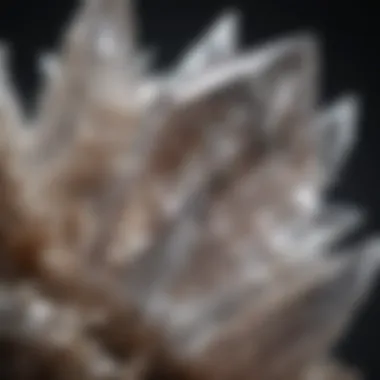
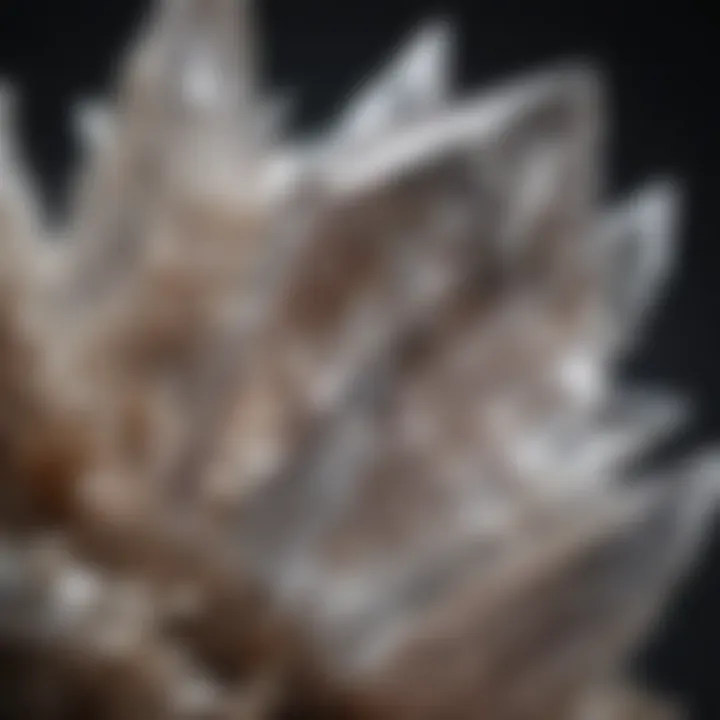
Intro
Large natural crystals fascinate both scientists and collectors alike. Their sheer size and unique properties make them remarkable specimens in nature. This article seeks to delve into various aspects surrounding these crystalline wonders, giving readers a robust understanding of their characteristics, geological origins, and the nuances of collecting them.
Understanding large crystals encompasses exploring their formation processes, delineating their traits, and appreciating their value in both scientific research and the collector's market. Responsible collecting is also crucial; it ensures that these natural treasures are maintained for future generations. Let's begin our exploration by examining the history and origins of these exceptional formations.
History and Origins
Overview of Collectibles, Rocks, and Fossils
The world of collectibles has always included an intricate tapestry of rocks and fossils. Within this realm, large natural crystals hold a unique position. Crystals have been collected for centuries, admired not only for their beauty but also for their believed metaphysical properties. Geologically, these minerals tell stories that date back millions of years, each piece offering insights into Earth’s history.
Crystals like quartz, amethyst, and citrine are some of the most popular among collectors. Many of them are formed under specific conditions that usually involve pressure and heat deep within the Earth's crust. Metal ores and other gemstones often undergo similar transformations, earning them their own rightful place in the collectibles market.
Historical Significance and Cultural Impact
Throughout history, large natural crystals have left an indelible mark on various cultures. Ancient civilizations used stones like lapis lazuli and turquoise for jewelry, ceremonial items, and as symbols of wealth. In many indigenous cultures, these crystals were viewed as having spiritual significance, often used in rituals and traditions.
The advent of the Enlightenment era saw a more scientific interest in geology and mineralogy. Significant figures in this period began cataloging and studying crystals, leading to a structured approach to classification that we still use today. The appreciation for these stones transcends mere aesthetics; they serve as a reminder of our planet's dynamic processes.
As our comprehension of these natural wonders evolved, so did the methodologies for their identification and classification.
Identification and Classification
Guide to Identifying Rocks and Fossils
Identifying large natural crystals requires knowledge and practice. Key factors include:
- Color and Clarity: These elements often determine a crystal's appeal and market value. Often more vibrant colors and exceptional clarity make specimens more desirable.
- Hardness: The Mohs scale measures the hardness of minerals. Knowing how a specimen ranks can aid in identifying it.
- Crystal Structure: Familiarity with how crystals form—whether hexagonal, cubic, or otherwise—can provide insights into their classification.
Common Types and Variations
Understanding the common types of large crystals enhances the collector's experience. Some notable examples include:
- Quartz: Highly sought after due to its abundance and variety. Variations include smoky quartz and citrine.
- Amethyst: A popular purple variety of quartz, prized for its vibrant color.
- Calcite: Notable for its rhombohedral cleavage and diverse color range.
Crystals are as varied as they are beautiful, but their value also depends on their rarity, quality, and demand within the collector community. Collectors should educate themselves on market trends as well as ethical collecting practices to ensure they do their part in preserving these natural gems.
"The quest for knowledge in the field of mineralogy not only enriches collectors but also contributes significantly to our understanding of Earth's geology."
This foundational knowledge sets the stage for a deeper exploration into the characteristics, origins, and distinct values of large natural crystals. Further segments will illuminate the essential aspects for identifying and appreciating these extraordinary geological formations.
Prelims to Large Natural Crystals
Large natural crystals captivate many through their fascinating formation and unique characteristics. Knowing about large crystals is essential for several reasons. They are not only significant within the realms of geology and mineralogy but also hold substantial appeal for collectors and enthusiasts alike. The growing interest in these geological marvels has sparked a movement among collectors, making it essential to understand their defining features, origins, and overall value.
The exploration of large crystals assists in appreciating their natural beauty and rich history. For many, collecting large crystals is more than just a hobby; it is a pursuit filled with historical narratives and scientific importance. These natural wonders can serve as educational tools, helping to understand Earth's processes and geological history.
By examining the various types of large crystals available in nature, collectors can develop a keener eye for the qualities that make these specimens truly exceptional. From crystallography to the geological conditions that favor their growth, every aspect contributes to the allure surrounding large natural crystals. As you delve deeper into the topic, clear knowledge of these elements will enhance your experience as a collector and your appreciation for these magnificent mineral specimens.
Definition and Overview
Large natural crystals are defined as mineral formations that have grown to substantial sizes, often taking on distinct geometric shapes and exhibiting specific crystalline structures. These formations occur when mineral elements combine under certain geological conditions. In many cases, such crystals can be hundreds of times larger than typical specimens. The size, clarity, and color often dictate the desirability of these crystals among collectors.
Crystallography, the study of crystal structures, plays a critical role in understanding large crystals. Each mineral has a unique lattice structure, determining its physical properties and overall appearance. Crystals like quartz, amethyst, and fluorite, to name a few, are widely recognized among collectors and can vary dramatically in size and form.
Large crystals have gained recognition as both scientific specimens and decorative pieces. In geology, they provide insights into the conditions under which they formed, while in terms of collectibility, they are valued for their aesthetic appeal, rarity, and historical significance.
Historical Significance
The historical significance of large natural crystals is profound. Throughout human history, civilizations have admired and utilized crystals for various purposes. Ancient cultures often attributed spiritual or healing properties to these stones. Crystals were used for ornamentation, trade, and even religious rituals.
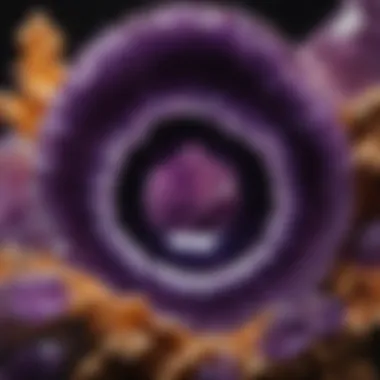

For instance, in ancient Egypt, large quartz crystals were carved into stunning jewelry pieces and used in burial practices, indicating a strong belief in their protective and healing qualities. The ancient Greeks also revered crystals, associating them with the divine and using them in various forms of art and decoration.
In modern times, large crystals continue to play a critical role in understanding Earth’s geological past. Their presence can indicate the environmental conditions that prevailed over thousands or millions of years. Collectors and scientists alike recognize crystals not only for their beauty but also for the narratives they tell about the Earth's history. As such, large crystals are considered valuable—both culturally and scientifically—as they offer a tangible connection to our planet's geological and historical journey.
Defining Characteristics of Large Crystals
Understanding the defining characteristics of large crystals is crucial for anyone interested in geology or mineral collecting. These characteristics provide insight into the development, classification, and beauty of crystals, making them fascinating subjects for study and appreciation. Knowing how to recognize these features enhances the collector’s experiences and informs proper care and valuation of these natural treasures.
Crystallography Basics
Crystallography is the scientific study of crystals and their structures. At the core of crystallography lies the concept of the crystal lattice, which is a three-dimensional arrangement of points representing the positions of atoms or molecules in a crystal. This arrangement defines the symmetry, shape, and physical properties of the crystal. There are several crystal systems, including:
- Cubic: Charactersized by equal axis lengths and angles, common in diamonds.
- Tetragonal: Similar to cubic but with one axis longer than others, found in some forms of zircon.
- Hexagonal: Includes sapphires and quartz, noted for their six-sided structures.
The study of crystallography offers insights into how these structures form, grow, and change over time. These principles help collectors assess the quality and authenticity of large crystals. A well-formed crystal often exhibits a clear, well-defined symmetry that is visually appealing and more valuable.
Common Features
Common features of large natural crystals can greatly influence their collectibility and appeal. Here are several notable characteristics to consider:
- Size: Larger specimens are often rarer and more desirable. The size can greatly affect visual impact and value.
- Clarity: Clear and transparent crystals are typically more sought after. Inclusions or cloudiness can diminish value, unless they form unique patterns.
- Color: Vibrant or unique colors can elevate the desirability of a crystal. However, color can be influenced by impurities or radiation exposure.
- Crystal Habit: This refers to the general shape of the crystal. Common habits include prismatic, fibrous, and granular. The specific shape can indicate the conditions under which it grew.
- Luster: The way a crystal reflects light can influence its aesthetic value. Crystals can exhibit a range of lusters from glassy to metallic.
Keeping these characteristics in mind can help collectors make informed choices when acquiring large natural crystals for personal collections.
By understanding these defining traits, one can appreciate the intricate beauty of large crystals and recognize their value in both the scientific study and the collector's market.
Types of Large Natural Crystals
Understanding the various types of large natural crystals is central to the exploration of this topic. Each type displays unique characteristics which reflect not only their formation processes but also their potential value in the collecting community. This section will provide insight into several prominent varieties including Quartz, Amethyst, Citrine, Fluorite, and Lapis Lazuli. By examining these types, collectors can inform their choices based on aesthetics, historical relevance, and unique properties.
Quartz Crystals
Quartz is the most abundant mineral in the Earth's crust and serves as a fundamental component of many large crystals. Its formation occurs in a variety of geological settings, making it accessible and frequently collectible. There are several varieties of Quartz including Clear Quartz, Rose Quartz, and Smoky Quartz. Each variation possesses distinct attributes. For instance, Clear Quartz is often valued for its clarity and versatility, making it ideal for various uses in both decoration and healing practices.
"Quartz is not just a rock; it is a bridge that connects us to different geological processes."
Collectors appreciate Quartz for its aesthetic value and range of sizes. Large Quartz crystals can serve as focal points in any collection, attracting interest from both laypersons and experts alike. Furthermore, Quartz serves a significant purpose in scientific research, primarily in geology and material sciences.
Amethyst and Citrine
Amethyst and Citrine are notable members of the Quartz family, both characterized by their unique colors and properties. Amethyst, known for its rich purple hue, has origins linked to volcanic activity. Historically, it was revered for its supposed protective qualities against intoxication. This gemstone is often found in geodes, making spectacular displays of amethyst clusters highly sought after among collectors.
On the other hand, Citrine, with hues ranging from pale yellow to deep orange, is celebrated for its stimulating properties. Both Amethyst and Citrine hold value not just for their visual appeal but also for their metaphysical beliefs, which add layers of significance for certain collectors. However, it is essential to verify authenticity, as heat-treated Amethyst can be mistaken for Citrine.
Fluorite
Fluorite, distinguished by its vibrant colors and cubic crystal structure, is another captivating type of large crystal. It can form in a range of colors, including purple, green, yellow, and clear. The coloration often occurs in bands, providing stunning visual effects that collectors find appealing. Fluorite is widely known for its fluorescence, where it emits visible light under ultraviolet radiation.
From an industrial perspective, Fluorite is significant due to its use in steelmaking and aluminum production. Thus, large specimens are not only stunning to behold but also valuable for their applications, making them increasingly collectible. Careful consideration of the source can enhance the ethics of collecting these crystals.
Lapis Lazuli
Lapis Lazuli is distinctive for its deep blue color and has been used for thousands of years in art and jewelry. Composed primarily of Lazurite, it often contains golden flecks of Pyrite, creating a luxurious appearance. Lapis Lazuli’s historical significance spans various cultures, particularly in Egypt, where it was esteemed in both decoration and burial. This connection to history adds a unique dimension to its collectibility.
The richness of its color and historical background makes Lapis Lazuli a favored choice among collectors of large natural crystals. Its rarity in high-quality forms further increases its collectibility, often reflected in steep market values. Understanding the historical context becomes essential when curating a collection.
Each type of large natural crystal discussed here reveals a fragment of our planet's story. Whether influenced by geological processes or enriched by human culture, these crystals possess details that resonate with collectors and science enthusiasts alike. Collecting these types not only satisfies a passion for nature but also fosters an appreciation for historical significance and ethical considerations in sourcing.
Formation Processes of Large Crystals
Understanding the formation processes of large crystals is essential for both collectors and scientists. These processes define not only the physical characteristics of the crystals but also their origins and collectibility. Knowledge of how crystals form can enrich the appreciation for these natural wonders and influence their market value. Whether one is a seasoned collector or a novice, recognizing the geological and hydrothermal factors at play can enhance one’s ability to identify and assess these crystals.
Geological Conditions

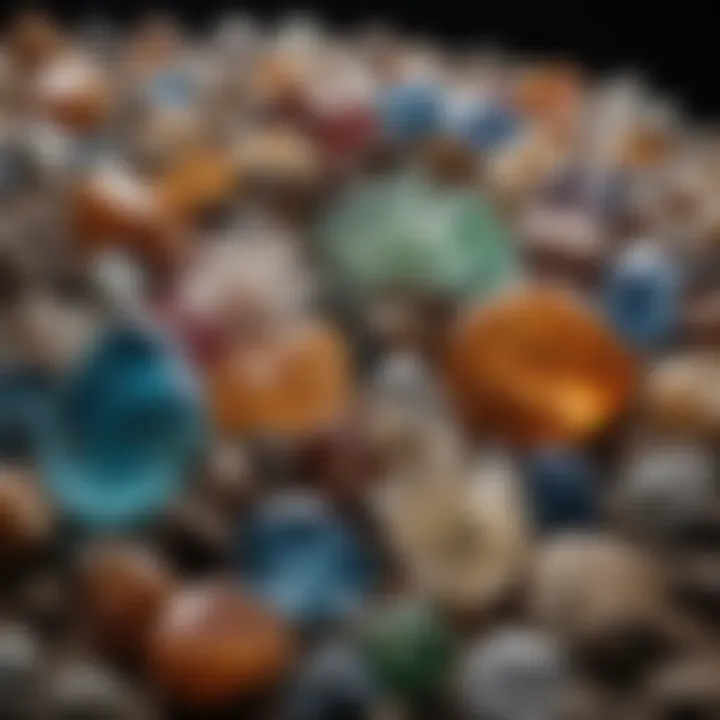
The geological environment plays a crucial role in the development of large crystals. Several factors contribute to the formation of crystals, including temperature, pressure, and the presence of certain minerals. The ideal conditions for crystal growth typically involve slow cooling of molten rock or the evaporation of mineral-rich water.
- Temperature: High temperatures can dissolve more minerals, allowing for larger crystals to form as conditions change. Crystals tend to grow larger under stable temperatures that prevent rapid changes in their environment.
- Pressure: Increased pressure can lead to crystallization when molten rock or mineral-rich fluids are forced into cracks in the Earth’s crust. This pressure alters solubility levels, promoting the growth of large crystals.
- Mineral Presence: The availability of specific elements dictates which type of crystals will form. If there is an abundance of quartz in the surrounding rock, for example, then quartz crystals are more likely to appear as large formations.
These geological factors often operate over thousands to millions of years, making the resulting crystals invaluable specimens of Earth's history. Collectors often seek crystals that originate from unique geological settings, as these can provide a richer story and context.
Hydrothermal Processes
Hydrothermal processes are another significant mechanism behind the formation of large crystals. These processes involve the interaction of hot water rich in minerals within the Earth. This mineral-laden water can travel through fractures and pore spaces, depositing minerals as it cools and loses pressure.
The hydrothermal environment is marked by:
- High Temperatures: Typically exceeding 200 degrees Celsius, the heat enables the water to dissolve various minerals. As it rises and cools, the dissolved minerals crystallize to form distinct shapes.
- Chemical Reactions: The minerals present can react with one another under high temperatures and pressures, leading to the formation of new minerals or modified existing ones.
- Fluid Movements: Turbulent movements of hydrothermal fluids can enhance the transport of minerals, affecting the size and quality of the resulting crystals.
Hydrothermal crystals are often considered some of the most aesthetically appealing specimens due to their intricate formations and vibrant colors.
Investors and collectors are keenly aware of the implications of hydrothermal processes on crystal formation. Understanding these dynamics can reveal insights into potential future values of crystals based on their places of origin and formation processes. The history portrayed in these stones is not solely of beauty; it also speaks of a complex interaction of earth processes that have occurred over vast time scales.
By grasping these critical concepts around geological and hydrothermal processes, collectors can make informed choices and appreciate their large natural crystals beyond their surface beauty.
Collectibility and Market Value
The collectibility and market value of large natural crystals hold significant importance for enthusiasts and researchers alike. As these natural formations often represent not just geological wonders but also artifacts of culture and history, understanding their market value provides insight into both their economic and sentimental worth. This section addresses the various factors influencing their value, the needs of collectors, and current market trends that shape this fascinating niche.
Factors Affecting Value
Several elements contribute to the market value of large natural crystals. Firstly, rarity plays a crucial role; crystals that are hard to find or that display unique qualities fetch higher prices. For example, a large, flawless amethyst may retain more value than one with inclusions or damage. The condition and quality of the crystal are also paramount. High-quality specimens, those with clarity and color saturation, are more sought after.
Additionally, the size of the crystal is significant. Larger specimens tend to attract more attention, creating a premium for larger pieces. The overall demand for specific crystal types can fluctuate, influenced by trends and the current preferences of the collector community.
Another vital aspect is provenance. A crystal with a documented history or one sourced from a notable location often has increased value due to its background. This includes credible sourcing methods and documentation of how it was obtained, especially in light of ethical collecting practices.
Furthermore, market timing can influence prices. The demand for large natural crystals may peak during certain seasons or economic conditions, impacting their collectibility. Collectors should be mindful of these trends and how they relate to their collecting goals.
"The value of a crystal is not solely determined by its aesthetics; a rich history enhances its allure."
Trends in Collecting
The trends in collecting large natural crystals have evolved, reflecting both changes in buyer preferences and broader societal issues. In recent years, there has been a notable increase in interest toward ethically sourced crystals. As awareness grows regarding environmental concerns and the impact of extraction methods, collectors are leaning toward crystals that guarantee responsible sourcing.
Another trend is the emergence of online marketplaces. Platforms like Reddit and Facebook have created communities where collectors can exchange knowledge and trade. This digital shift allows for easier access to a broader audience, promoting more significant exposure to unique and rare specimens.
Micro-collecting has also gained traction. Enthusiasts are increasingly interested in smaller, but still stunning, pieces that provide the same aesthetic value as larger ones. This shift opens avenues for new collectors who might find the entry barriers of large crystals to be too high.
Moreover, the role of social media cannot be overlooked. As collectors share images of their displays on platforms like Instagram, they influence market trends, targeted searches, and desirability of specific crystals on a global scale.
Caring for Large Natural Crystals
Caring for large natural crystals is essential not only for maintaining their physical beauty but also for preserving their value. Crystals are often collected for their aesthetic appeal, scientific interest, or both. Yet, improper handling or maintenance can lead to irreversible damage. Consequently, knowledgeable collectors should adopt practices that ensure their specimens remain in optimal condition. This guide focuses on two key aspects of crystal care: cleaning techniques and storage recommendations.
Cleaning Techniques
Cleaning crystals properly is vital for removing dust and contaminants without damaging the surfaces. Different types of crystals may require specific approaches due to their unique properties. Here are some commonly accepted methods:
- Gentle Rinsing: For most crystals, a simple rinse under lukewarm water can be effective. Avoid using hot water as it can cause thermal shock, particularly in more sensitive materials.
- Soft Brushes: Use a soft-bristled brush to scrub away dirt on surfaces. Avoid hard brushes, as they can scratch delicate crystals.
- Soap Solutions: For tougher grime, a mild soap solution can be applied. Ensure the soap is free from harsh chemicals and fragrances. Rinse thoroughly afterward to remove any soap residue.
- Ultrasonic Cleaners: These machines can clean crystals effectively with sound waves. However, not all crystals are suitable for this treatment. Avoid using ultrasonic cleaning on soft or porous specimens.
- Avoid Chemicals: Harsh chemicals should be avoided. Substances like bleach or ammonia can damage crystals severely. Always err on the side of caution and stick to simple methods.
"Proper cleaning enhances the visual appeal of crystals while preserving their integrity."
Storage Recommendations
Storing large natural crystals correctly is crucial for protecting them from physical damage and environmental factors. Consider the following storage tips:
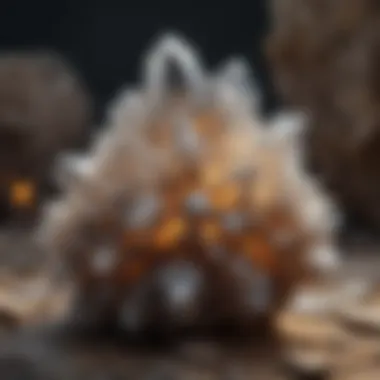
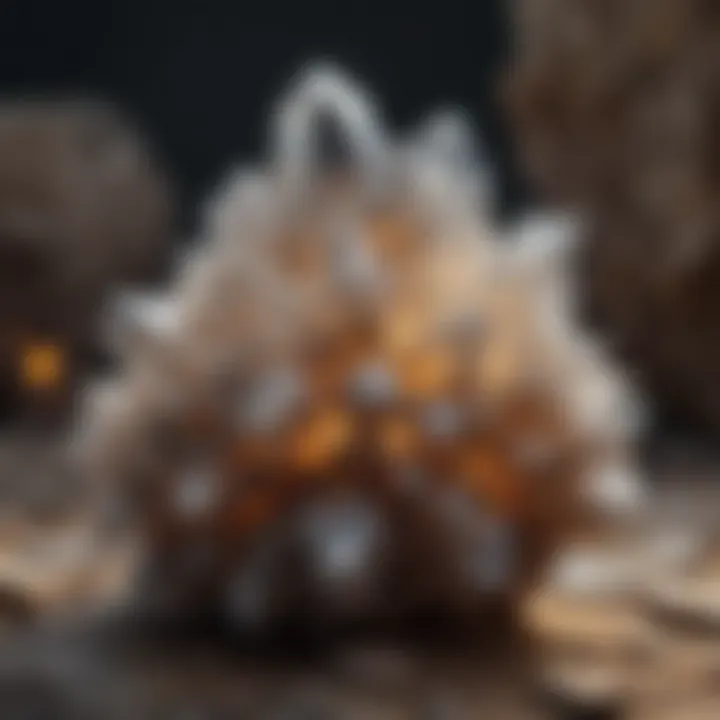
- Avoid Direct Sunlight: Prolonged exposure to sunlight can fade colors and alter the appearance of some crystals. Store them in a shaded area.
- Use Soft Materials: When placing crystals on shelves or in display cases, use soft cloths or padding to prevent scratching. Materials like felt or microfiber work well.
- Stable Temperature and Humidity: Crystals can be sensitive to temperature fluctuations and humidity. Maintain a stable environment to avoid thermal expansion or contraction, which can lead to cracks.
- Keep Them Separated: Avoid stacking or placing crystals in direct contact with each other to prevent chips or scratches. Individual boxes or padded containers are ideal.
- Secure Display Cases: If displaying crystals, ensure cases are secure and protect the specimens from potential falls or impacts.
Proper care and maintenance are integral to enjoying and preserving large natural crystals for future generations. With thoughtful cleaning methods and careful storage strategies, collectors can safeguard their treasures and ensure they retain both beauty and value.
Ethical Considerations in Collecting
Collecting large natural crystals is not only a pursuit of beauty and rarity, but also a responsibility that involves various ethical considerations. As collectors navigate this field, they must be acutely aware of the implications of their actions, including how and where these crystals are sourced. Understanding these principles enriches the community of collectors and promotes sustainable practices across the globe.
Responsible Sourcing
When it comes to responsible sourcing, collectors should prioritize how crystals are obtained. It is essential to ensure that they come from legitimate and ethical sources, minimizing the risk of contributing to illegal mining operations or exploitation of local communities. Collectors can foster ethical practices by:
- Researching the origins of their crystals
- Asking vendors about extraction methods
- Supporting suppliers who prioritize fair labor practices
- Participating in organizations that advocate for ethical collection
By securing crystals from responsible sources, collectors help mitigate the repercussions that can arise from the gemstone trade, such as the degradation of local ecosystems and the social injustices that often accompany resource extraction.
Environmental Impact
The environmental impact of crystal collecting is an often-overlooked aspect of the hobby. Mining activities can lead to significant ecological damage, including habitat destruction and pollution of local water sources. To reduce their footprint, collectors should consider:
- Opting for crystals that have been collected through sustainable practices
- Supporting initiatives that focus on restoration and conservation
- Being mindful of regulations that govern mining in various regions
In addition, it is essential for collectors to be informed about the broader environmental issues tied to mineral extraction. By taking these factors into account, collectors can play a role in promoting a more sustainable approach to the acquisition and appreciation of large natural crystals.
"Ethical considerations in crystal collecting are not just a trend, but a necessary stance to preserve our planet for future generations."
Ultimately, by incorporating ethical considerations into their collecting practices, enthusiasts can enjoy their passion while also ensuring that they leave a positive impact on the environment and support the communities involved in the crystal trade.
Scientific Research and Large Crystals
Scientific research into large natural crystals provides critical insights into both the Earth's geological history and practical applications in various industries. Crystals, especially large specimens, can reveal much about the conditions under which they formed. Their structure, composition, and growth patterns inform geologists about past environmental conditions. Furthermore, understanding these large natural crystals aids in material science, electronics, and other high-tech applications.
Role in Geology
Large crystals serve as essential clues in geological studies. They can indicate the processes that shaped the Earth’s crust over millions of years. For instance, quartz crystals often form in igneous rocks, serving as indicators of the cooling rates of magma. In sedimentary contexts, crystals like calcite can tell researchers about the chemical conditions of ancient marine environments.
- Information on geological time: Large crystals help establish timelines. By studying their growth patterns, scientists can draw conclusions about specific geological periods.
- Mineral deposition: Large crystals often develop in veins or cavities. Analyzing these can reveal the mineral deposition processes and associated temperature and pressure conditions.
Moreover, the study of these crystals can have implications for understanding tectonic activities, providing insights into earthquake-related phenomena. This is crucial for predicting geological hazards.
Applications in Industry
Large natural crystals have significant industrial applications. Their properties make them valuable in many high-tech sectors, including electronics, optical devices, and energy.
- Consumer electronics: Quartz crystals, for example, are vital in quartz watches and clocks. Their piezoelectric properties allow them to convert mechanical energy into electrical signals, facilitating very precise timekeeping.
- Industrial lasers: Crystals such as ruby and garnet are vital components in laser production. They contribute to the laser's ability to emit focused light across various wavelengths.
- Environmental monitoring: Certain crystals can be used to create sensors that detect environmental changes. For instance, some researchers study ionic crystals for their ability to react to changes in light or temperature, potentially aiding in climate studies.
- Aerospace applications: Large natural crystals also find applications in satellite technology and aerospace. Their lightweight and durable nature makes them invaluable for various manufacturing needs.
- Pharmaceuticals: The uniqueness of certain crystals provides insights into drug design and development, especially when it comes to molecular structures.
Research continues to explore the potential of large natural crystals in newer fields, ensuring that they remain relevant in scientific investigation and industrial innovation.
"The study of large natural crystals is not just about appreciating their beauty; it is about unlocking the secrets of our planet's formation and the future of technology."
Thus, scientific inquiry surrounding these crystals not only enhances our understanding of geology but also underscores their practical importance in addressing contemporary challenges.
Epilogue
Understanding large natural crystals is fundamental for both enthusiasts and collectors. This article emphasizes their unique characteristics, geological origins, and the various factors influencing their collectibility. Each aspect discussed contributes to a comprehensive view that enriches a reader's knowledge and appreciation.
Summarizing Key Points
- Defining Characteristics: Large natural crystals exhibit specific traits that set them apart. Their size, shape, and formation patterns provide insight into their geological history. The crystallography basics offer a scientific foundation to appreciate these elements.
- Types of Crystals: Various types of crystals such as quartz, amethyst, and lapis lazuli showcase the diversity within large natural crystals. Each type has its unique features and origins that collectors should be aware of.
- Formation Processes: The geological conditions and hydrothermal processes discussed help in understanding how these crystals form over time. This knowledge is essential for predicting where to find similar specimens.
- Collectibility and Value: Factors affecting the market value have significant implications for collectors. Recognizing trends and assessing qualities can lead to informed decisions when acquiring crystals.
- Care and Ethics: Proper care techniques and understanding the ethical considerations surrounding crystal collecting are vital. Responsible sourcing can help preserve the natural environments we value.
Future Trends in Crystal Collecting
In the coming years, the market for large natural crystals is expected to evolve.
- Increased Interest in Sustainability: As awareness of environmental impact grows, collectors may prioritize ethically sourced crystals over more readily available ones.
- Technological Advancements: Enhanced methods in gemological testing may arise, improving the ability to authenticate and evaluate crystals.
- Social Media Influence: Platforms like reddit.com and facebook.com are likely to continue shaping trends. Collectors may rely on these platforms for information exchange and community building.
- Emerging Markets: New geographic locations may gain recognition for their unique crystal deposits, expanding potential for new collectors.
Overall, the future looks promising for large crystal enthusiasts. By staying informed and adapting to new trends, collectors can elevate their passion into a deeper understanding and appreciation.



